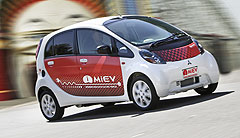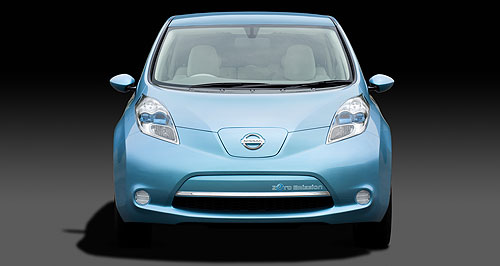Make / Model Search
News - General NewsHow green is your EV?Green Leaf: Nissan's Leaf will help to lead the electric vehicle charge in Australia. Power source determines electric-vehicle C02 savings – or not1 Sep 2009 AS THE electric vehicle (EV) market segment takes hold in Australia later this decade, in particular as sales move from small-scale initial allocations from pioneering brands to larger-volume, more affordable vehicles pitched at the private consumer from a range of marques, the car companies involved are faced with the prospect of a PR nightmare over our reliance on coal as the power source. Discussing how Australia would manage the expected EV influx, including its forthcoming (tailpipe) emissions-free Leaf EV, Nissan Australia managing director Dan Thompson last month acknowledged the need to counter criticism that widespread employment of EVs simply shifted the burden of CO2 emissions from the exhaust pipe to power stations. How valid is the criticism? An independent expert in EVs and EV infrastructure in Australia, senior research fellow Peter Pudney from the University of South Australia, has told GoAuto that while it was difficult to calculate the exact CO2 output of EVs given the different methods used to produce electricity across Australia, it was clear that running an EV on electricity generated by coal effectively negated the CO2 benefits over a car with a traditional combustion engine. “Essentially, if you are using brown coal (to generate electricity for your EV) you would be slightly worse off than a comparable vehicle using traditional fuel,” Dr Pudney said.  Left: Mitsubishi i-MiEV. Left: Mitsubishi i-MiEV.In a small market like Tasmania, where almost all electricity is generated by water, driving an EV will produce minimal emissions. But in a large market like Victoria, where most of the electricity comes from burning brown coal, an EV’s shade of green will turn a lot paler. Dr Pudney’s calculations include emissions produced in refining and transporting petrol, which have not been considered previously. It is important to note the complex mix of electricity generation in Australia, including natural gas, wind, solar, oil, hydro and brown and black coal. Then there is the impact of individuals fitting solar panels to their homes, which in some cases will not just be able to power the house but also charge an EV. The federal climate change department gives a good idea of how much CO2 is generated by electricity production in each state. It presents the information in terms of how many kilograms of CO2 is produced for each kilowatt hour of electricity. While 1kW hour of electricity produced in Tasmania generates just 0.23kg of CO2, the same amount of energy produced in Victoria means 1.22kg of CO2 is pumped into the atmosphere. EV customers, and anyone for that matter, can pay extra for green energy, and while the electricity they draw could still come from coal, it will at least pay for renewable electricity to be generated elsewhere. “We argue that anyone who is paying the extra to help the environment by buying an electric vehicle is almost certainly going to pay the extra for renewable energy,” Dr Pudney said. He said although an EV running on ‘green’ electricity would be more expensive than coal-generated energy, it would still be cheaper than running a petrol car. His calculation has a green energy EV costing around four cents a kilometre to run compared with eight cents a kilometre for a comparable petrol model. Currently, only eight per cent of Australia’s electricity is renewable, but the Rudd government recently announced a new target of 20 per cent by 2020. While car companies do not want to get too involved in EV infrastructure issues, Mr Thompson said EV customers could be forced, through a charging package, to use renewable energy sources. “Certainly if it is brown coal or dirty coal, that is an issue,” he said. “As part of the EV strategy, our intention is that when somebody plugs into the grid, they are tapping into an renewable energy source, and so planning that needs to be done to ensure that this is the case. “It is likely that this will be packaged somehow into the business model, so when somebody buys an EV, they have a charging package that ensures that it is sourced from green power. “We are not trying to own the entire infrastructure, but we are encouraging this sort of packaging to accelerate the uptake of EVs.” Dr Pudney believes the only way state governments will move from coal and really push renewable energy is to make coal more expensive. “If we really want less emissions, coal prices have to go up to meet green power,” he said.  Read more |
Click to shareGeneral News articlesResearch General News Motor industry news |










Facebook Twitter Instagram